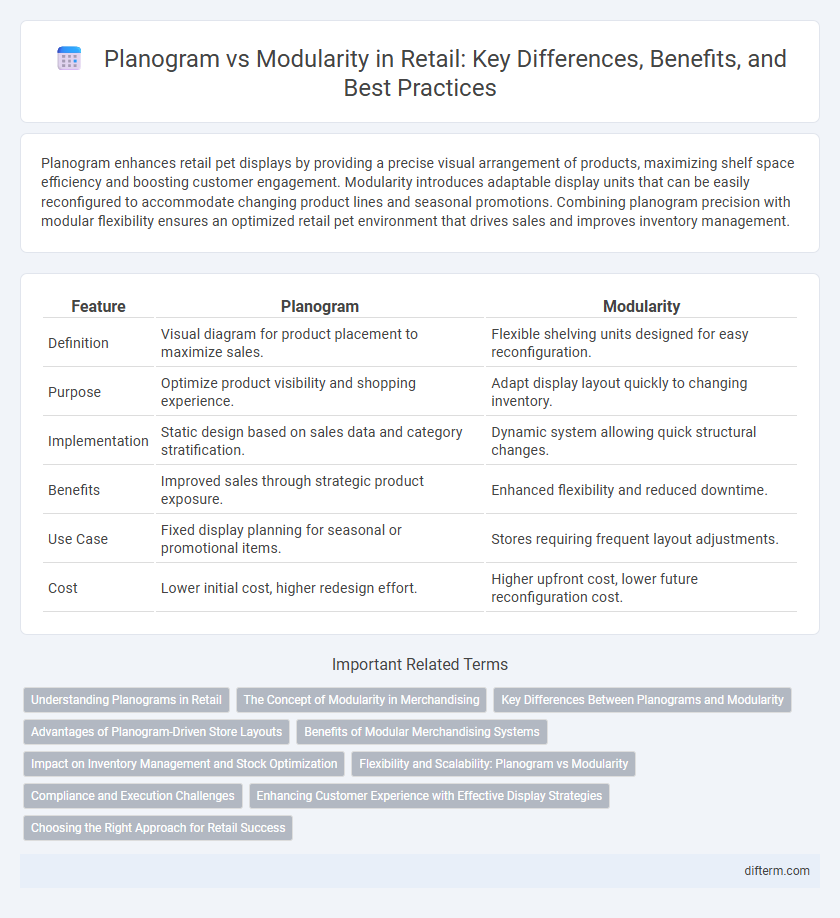Planogram enhances retail pet displays by providing a precise visual arrangement of products, maximizing shelf space efficiency and boosting customer engagement. Modularity introduces adaptable display units that can be easily reconfigured to accommodate changing product lines and seasonal promotions. Combining planogram precision with modular flexibility ensures an optimized retail pet environment that drives sales and improves inventory management.
Table of Comparison
| Feature | Planogram | Modularity |
|---|---|---|
| Definition | Visual diagram for product placement to maximize sales. | Flexible shelving units designed for easy reconfiguration. |
| Purpose | Optimize product visibility and shopping experience. | Adapt display layout quickly to changing inventory. |
| Implementation | Static design based on sales data and category stratification. | Dynamic system allowing quick structural changes. |
| Benefits | Improved sales through strategic product exposure. | Enhanced flexibility and reduced downtime. |
| Use Case | Fixed display planning for seasonal or promotional items. | Stores requiring frequent layout adjustments. |
| Cost | Lower initial cost, higher redesign effort. | Higher upfront cost, lower future reconfiguration cost. |
Understanding Planograms in Retail
Planograms in retail serve as detailed visual representations that strategically outline product placement to maximize shelf space efficiency and enhance customer experience. By incorporating data-driven insights on consumer behavior and product performance, planograms optimize inventory visibility and drive sales growth. Compared to modularity, which emphasizes flexible shelving units, planograms provide precise guidance on product arrangement to ensure consistent brand presentation and streamlined store operations.
The Concept of Modularity in Merchandising
Modularity in merchandising refers to designing retail displays with interchangeable components that can be easily rearranged to adapt to different product assortments and store layouts. This concept enhances flexibility and efficiency, allowing retailers to quickly respond to seasonal changes, promotions, or inventory shifts while maintaining brand consistency. Unlike traditional planograms, modular systems prioritize scalability and adaptability, enabling dynamic merchandising strategies that optimize space utilization and improve customer experience.
Key Differences Between Planograms and Modularity
Planograms are detailed visual representations that specify product placement on retail shelves to maximize space utilization and enhance product visibility. Modularity refers to the design of shelving units and displays that can be easily reconfigured or adjusted to accommodate various product sizes and assortment changes. The key difference lies in planograms being a strategic layout tool focused on optimizing product arrangement, while modularity emphasizes physical flexibility and adaptability of retail fixtures.
Advantages of Planogram-Driven Store Layouts
Planogram-driven store layouts optimize product placement by leveraging detailed visual schematics, enhancing shelf space utilization and maximizing consumer exposure to high-margin items. These layouts facilitate data-driven decisions that increase sales efficiency, streamline inventory management, and improve shopper navigation through strategically organized product categories. Implementing planograms also promotes brand consistency across multiple store locations, contributing to a cohesive customer experience and stronger retail performance.
Benefits of Modular Merchandising Systems
Modular merchandising systems enhance retail efficiency by allowing flexible product placement and easy updates to displays, which optimize shelf space and improve inventory management. These systems support faster store resets and consistent brand presentation across multiple locations, boosting customer engagement and sales. Incorporating modularity into planograms reduces labor costs and increases adaptability to seasonal trends or promotional campaigns.
Impact on Inventory Management and Stock Optimization
Planogram-driven layouts enhance inventory management by providing precise product placement guidelines, which reduce stockouts and overstock situations through better visual control and demand forecasting. Modularity in retail fixtures allows flexible shelf reconfigurations that adapt to changing inventory levels and product assortments, optimizing stock turnover rates and minimizing space wastage. Combining planogram precision with modular systems results in improved stock accuracy and accelerated replenishment cycles, directly impacting sales performance and inventory costs.
Flexibility and Scalability: Planogram vs Modularity
Planograms provide structured product placement, ensuring consistent visual merchandising but often lack flexibility when adapting to changing inventory or seasonal shifts. Modularity offers scalable display components that can be easily reconfigured to accommodate new products or store layouts, enhancing operational agility. Retailers benefit from modular systems by quickly responding to market trends without the constraints of rigid planogram designs.
Compliance and Execution Challenges
Planogram compliance often suffers due to rigid layouts that fail to adapt to real-time inventory fluctuations and store-specific constraints. Modularity enhances execution by allowing flexible, scalable displays that can be quickly adjusted, improving shelf space utilization and reducing non-compliance rates. Retailers face challenges integrating modular systems with existing planogram standards, requiring advanced software solutions to monitor adherence and streamline execution processes.
Enhancing Customer Experience with Effective Display Strategies
Planograms strategically organize product placements on retail shelves to maximize visibility and guide customer purchasing decisions, while modularity allows flexible and easily adjustable displays that adapt to changing inventories and seasonal promotions. Combining planogram precision with modular display adaptability enhances ambiance, reduces shopper confusion, and encourages product discovery. Retailers leveraging both methods boost engagement and sales by creating intuitive, visually appealing environments tailored to customer behavior.
Choosing the Right Approach for Retail Success
Planograms provide detailed shelf layouts based on product placement and consumer behavior, maximizing visual appeal and sales per square foot. Modularity emphasizes flexible, reusable fixtures that adapt to changing inventory and promotional needs, enhancing operational efficiency and cost-effectiveness. Retailers should evaluate store size, product variety, and marketing goals to select the optimal combination of planogram precision and modular adaptability for sustained retail success.
Planogram vs Modularity Infographic

 difterm.com
difterm.com